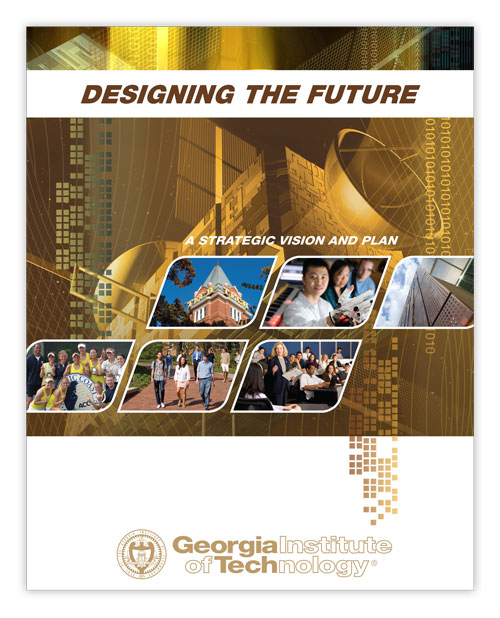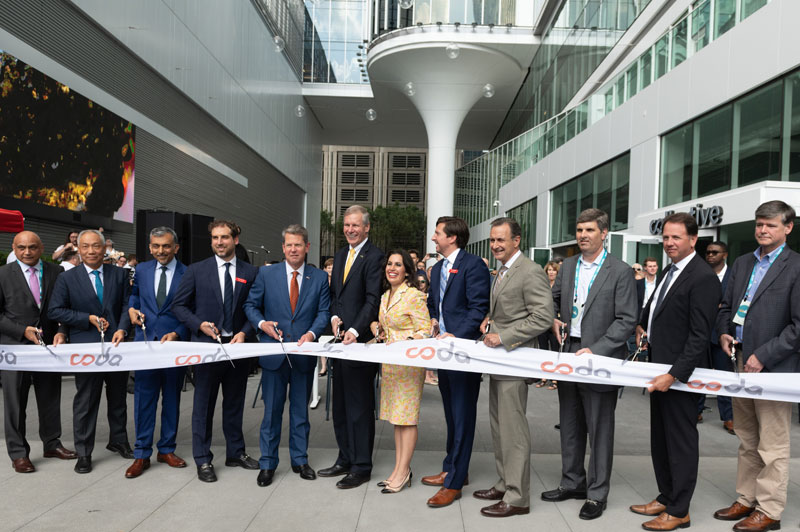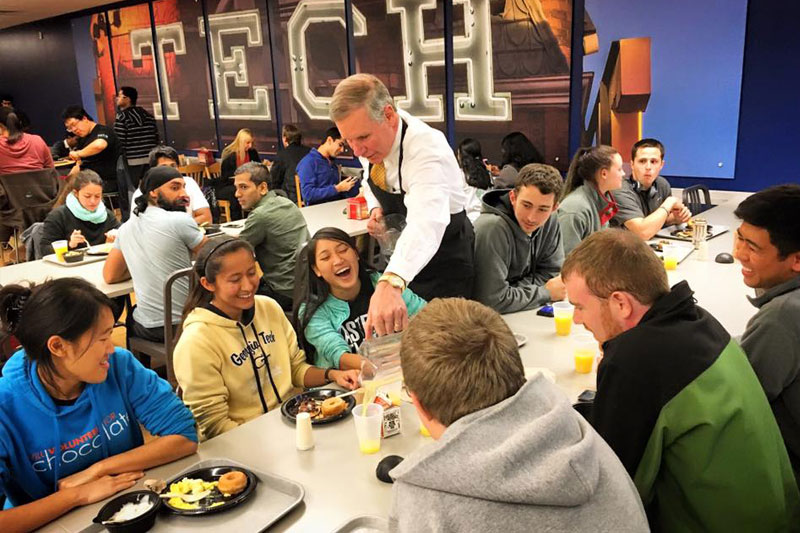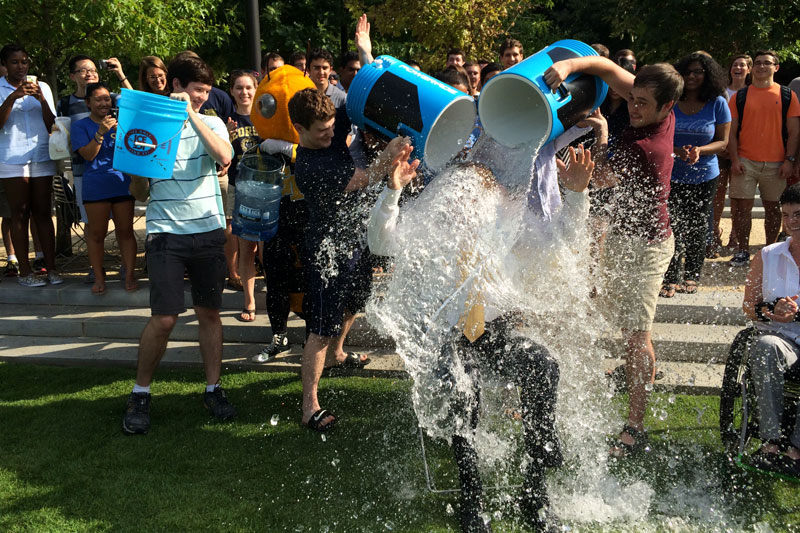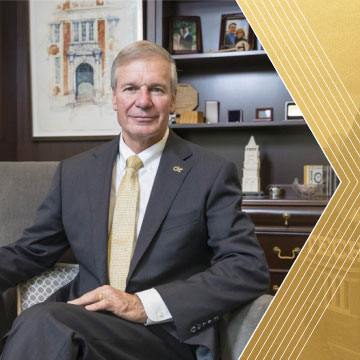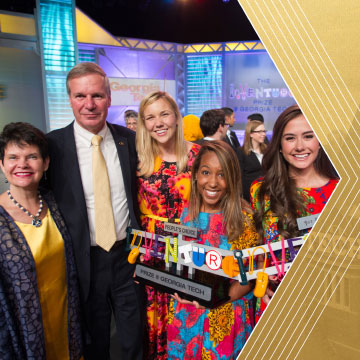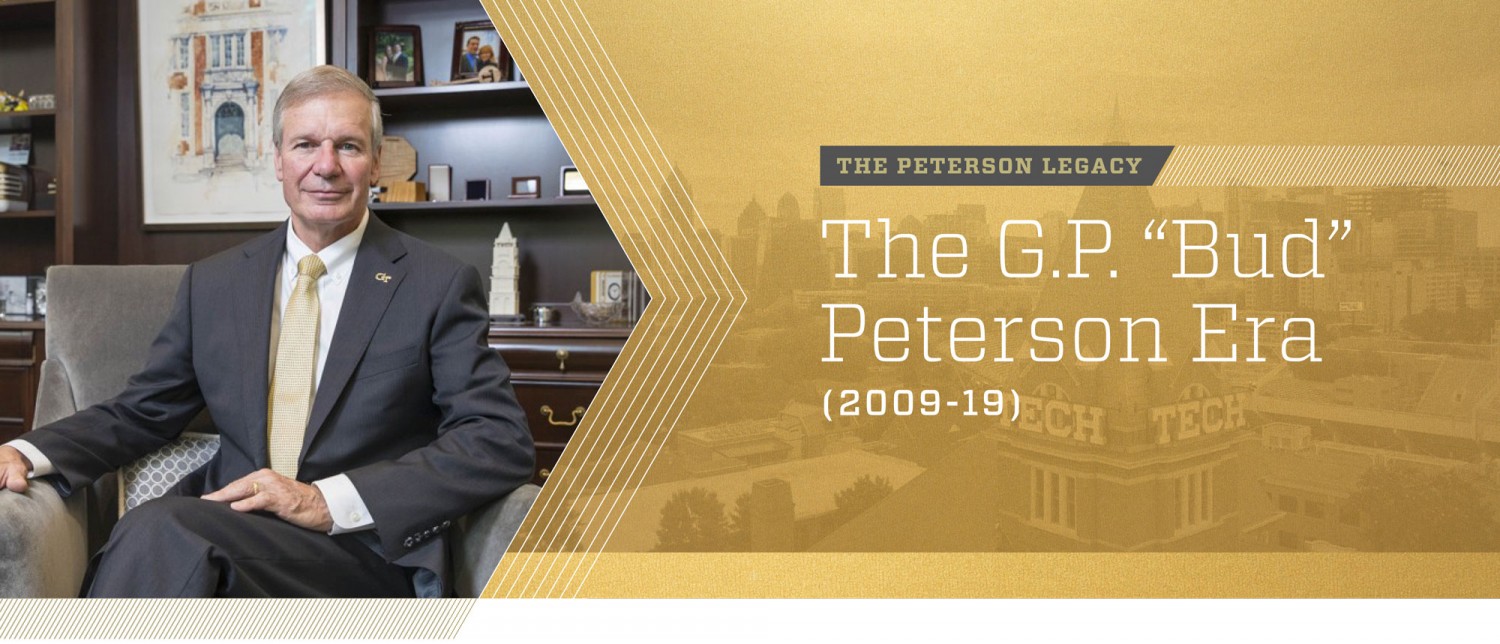
Tireless. Collaborative. Visionary. Committed. If you ask for a description of G.P. “Bud” Peterson, those are the words you’re likely to hear. When he took the helm as Georgia Tech’s 11th president in April 2009 with first lady Val Peterson at his side, a decade began of building on the Institute’s upward trajectory.
One of the first things he did was to bring the entire campus together to look beyond current constraints to develop a 25-year Strategic Plan, Designing the Future. It became the framework for many of the advances and accomplishments under his leadership, and was aligned with the launch of Campaign Georgia Tech's public phase. Focus areas identified in the plan became the springboard for increased collaboration with Emory University, Children’s Healthcare of Atlanta, and other partners in government and industry; a more flexible curriculum; new Living Learning Communities for students; an emphasis on helping students develop entrepreneurial confidence and a global mindset; and a big-picture approach to global expansion for the Institute.

of Georgia Tech undergraduates have an international experience before graduating.
Georgia Tech’s expansion across the globe during the past decade is unparalleled in its history. From Europe, to Asia, to Latin America, Georgia Tech has established new programs, research centers, and campuses, as well as research and education collaborations with more than 100 countries.
This growth has created extraordinary new opportunities for students to broaden their horizons and sharpen their skills to compete in a global economy. Today, 58% of Georgia Tech undergraduates have an international experience before graduating.
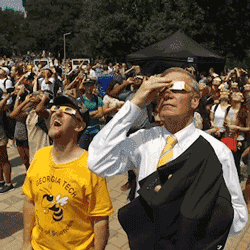
Another of the priorities outlined in the Strategic Plan was to develop the campus and community as a vibrant live-work-learn-play environment. That vision has come to life through the growth of Technology Square and other innovation neighborhoods surrounding the campus. Tech Square has the highest density of startups, corporate innovators, and academic researchers in the southeastern U.S. Since 2012, 35 corporate innovation and research centers and partners have located in and around Tech Square, largely because of their desire to access Georgia Tech research, faculty, and students — recognizing that they need to have an entrepreneurial mindset to build upon their successes, and to be nimble enough to apply new technologies and ideas. In addition, students and graduates enjoy living and working in and around these innovation neighborhoods, whether they’re working with corporations or developing their own startups.

The 3D-printed trachea splints, designed by Tech's Scott Hollister, enabled a groundbreaking pediatric surgery in Fall 2018.
Innovative thinking has always been part of the fabric of Georgia Tech, but it reached a new level during the Peterson era. Why not have student-run makerspaces throughout campus? Let’s move most of the books out of the Library and create a space for collaboration and innovation. What if we were to create an engineered biosystems building designed for interdisciplinary collaboration to tackle some of the world’s greatest health challenges? Let’s find a way to 3D print a trachea splint so that this baby can breathe. We should create an online master’s degree in computer science that would allow students around the world to earn the same degree offered on campus. What about a Georgia Tech commitment to a lifetime education?
Beyond all of that, President Peterson has been committed to creating an environment where students can succeed in all areas of their lives. A partnership with the Student Government Association led to the creation of a $1 million joint allocation committee as part of an expanded focus on mental health and well-being. The focus also included the Collegiate Recovery Program and the creation of the Center for Assessment, Referral, and Education (CARE) to provide a single entry point for students to all mental health resources. The Tech Ends Suicide Together program, for which Val Peterson served as spokesperson, was also established. And enhanced student initiatives now include the first Veterans Resource Center and the LGBTQIA Resource Center.

The LGBTQIA Resource Center opened its new facility in the Smithgall Student Services Building in August 2018.
Both President Peterson and first lady Val Peterson have encouraged, mentored, and inspired the next generation of leaders. Together, they have been visible, accessible, and enthusiastic supporters of Georgia Tech. They can often be found on campus participating in new student move-in activities, or in events such as Midnight Breakfast at the start of Finals Week, and Athletics and InVenture Prize Competition events.

The Petersons have also demonstrated a strong commitment to putting a Georgia Tech education within the reach of qualified students with financial need. President Peterson led the charge to strengthen endowments for need-based undergraduate scholarships. He significantly expanded the G. Wayne Clough Georgia Tech Promise program to $65 million to cover educational expenses for qualified Georgia residents with a household income below the federal poverty level, and since 2009, more than 550 Tech Promise Scholars, all of them Georgia residents and many the first in their families to attend college, have earned Tech degrees.
President Peterson also initiated the APS Scholars program in 2014, offering automatic acceptance and four-year in-state tuition scholarships to all Atlanta Public School valedictorians and salutatorians, as well as the Georgia Tech Scholars program in 2017, offering automatic acceptance to valedictorians and salutatorians in every accredited high school in Georgia. Additionally, the Institute became the first school to provide a matching-fund commitment to support the Governor’s REACH program.
To honor the decade-long legacy of Georgia Tech’s 11th president, the G.P. “Bud” Peterson and Valerie H. Peterson Scholarship Endowment Fund was announced at the June 2019 meeting of the Georgia Tech Foundation. The fund was established to help students with demonstrated financial need from across the nation. The Foundation is directing a grant of $5 million to support the initiative. Combined with initial gifts and commitments of over $12 million provided by more than 100 Foundation trustees, along with members of the Georgia Tech Advisory Board and the Alumni Association executive committee, it is the largest single scholarship endowment fund in Georgia Tech’s history.

